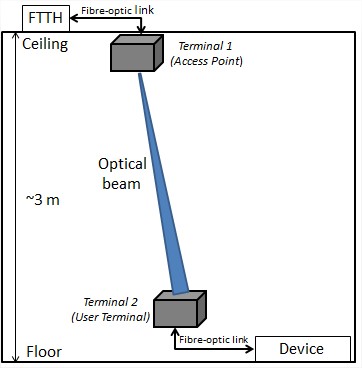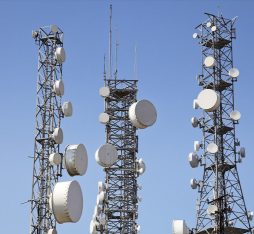“Data transmission is extremely secure because the optical light beam is highly directional and power consumption is low, offering connectivity with guaranteed throughput for each user thanks to point-to-point communication.”
Introduction
In 1889, Nikola Tesla created a high-frequency radio generator. A few years later, he tested the world’s first wireless communication. Then, in 1897, Guglielmo Marconi accomplished the first radio communication, using Morse code signals, over a distance of 14 km in Great Britain. This marked the beginning of the remarkable progression of radio communication through a wide-range of applications, from radar and television to smartphones and Wi-Fi.
In the 1960s, benefitting from the joint discoveries of the laser and light detectors, researchers came up with the idea of using silica fibre to carry a light signal that could transport information at a very high speed — the speed of light. And a decade later, given the evolution of communication services and their ever-increasing bandwidth requirements, fibre optics would progressively come to replace copper wire connections. The capabilities offered by fibre optics in terms of speed and low linear attenuation enabled long-distance connections of several hundred kilometres without repeaters. Indeed, fibre-optic transmission systems have a capacity of several Tbps, making them the preferred medium for carrying large amounts of data in communication networks [1]. Fibre optics were first used to establish long-distance connections, by linking intercontinental and transcontinental communication nodes, for instance. Today, ever-growing bandwidth requirements have resulted in the large-scale deployment of fibre optics, making this technology increasingly accessible to customers. For example, the rapid development of PONs (Passive Optical Networks) provides increasingly high speeds for homes and businesses [2].
Alongside progress in photonics for telecommunications, the world of lighting and display also underwent a technological revolution through the use of LEDs (light-emitting diodes). This solution was also applied to telecommunications because LED light intensity can be varied very quickly and can therefore transmit binary messages. Lasers also played a part in this technological wave, enabling local wireless optical connections. The first solutions, mainly for military purposes, were outdoor point-to-point devices (FSO — Free Space Optics) and, more recently, point-to-multipoint commercial applications have become available for general deployment within a room (Li-Fi — Light Fidelity) [3]. Today’s very high-broadband wireless communications, via radio frequency in the terahertz spectral band or in the optical band, use narrow communication beams that have to point at each other in order to connect the terminals. The established connections must be within Line Of Sight (LOS).
The WORTECS European collaborative project (https://wortecs.eurestools.eu/) has entered a new realm of research known as Fi-Wi (Fibre Wireless), the working principle of which is extremely simple. Inside a room, it involves taking the light beam of an optical fibre from the AP (Access Point) and automatically pointing it at the UT (User Terminal), and of course reciprocating this in the other direction, in order to attain very high speed bidirectional communication (Figure 1).
This new idea enables a direct connection to be established between two optical fibres, removing much of the complexity of converting the optical signal into an electrical signal (and vice versa), as well as the complexity of the alternative option of processing and regenerating the radio signal. Fi-Wi connections are therefore inherently bidirectional and transparent to the modulation format or protocol and to the wavelength. The proposed connection offers a throughput of between 1 Gbps and 1 Tbps (up to a theoretical maximum that is currently estimated to be 44.2 Tbps) without changing the AP or UT. Data transmission is extremely secure because the optical light beam is highly directional and power consumption is low, offering connectivity with guaranteed throughput for each user thanks to point-to-point communication.
Today, it is being initially used for immersive services based on VR (virtual reality) or AR (augmented reality) techniques, which require high data transmission speeds of around 100 Gbps per terminal, with video compression and very low latency. There are several possible applications of Fi-Wi, such as remote surgical operations without electrical or radio conversion, or in Virtual Reality Arcades. In the medium term, one possible use could be holographic video call communication, which requires speeds of several Tbps and latency of less than one microsecond.

Fig.1: Fi-Wi connection

Fig.2: Fi-Wi prototype
Figure 1 shows the working principle: The system consists of an Access Point (AP) and a User Terminal (UT), with an accurate detection and tracking device that allows each terminal (1 and 2) to point towards each other. Each terminal sends a narrow beam of light from an optical fibre to the other terminal. The two terminals track and automatically adjust to user movements in order to maintain bidirectional communication while the user is moving around. Figure 2 shows the first prototype version.
Success
The Fi-Wi solution provides an opportunity for an end-to-end, wireless and all-optical network, and research in this area has generated growing interest [4] – [6]. Fi-Wi terminals typically incorporate a light hub as well as a beam localisation and tracking unit to keep track of user movement. Several devices have already been introduced [7] – [9] and rely on point-to-point connections, such as FSO. But to be able to support user movements without any service disruption, the various prototypes use FSMs (Fast Steering Mirrors) [10] – [15], SLMs (Spatial Light Modulators) [16] or passive diffraction grating [17] and [18].
The WORTECS project proposes using standard FSMs and commercial cameras that allow detection and tracking functions to be integrated into a simple and compact housing [19] and [20] (Figure 2). Lab experiments demonstrated a transmission capacity of 1 Tbps with current coverage of 4.9 m2. In collaboration with the B-COM technological research institute in France, a 10 Gbps wireless optical link was recently tested with commercially available SFP (Small Form-factor Pluggable) optical modules. The wireless optical connection was established between a VR content server and a VR headset for real-time communication.
Next stage
This new approach is a real technological breakthrough, directly connecting the fibre-optic network and the terminals via a Fi-Wi solution. The second version of this prototype will be available to view at https://www.wortecs.com from 15 October 2020.
The next steps will consist of widening the scope for innovative solutions, especially in multi-user mode. A contribution to the standardisation effort will also be submitted with a view to proposing an interoperable solution based on an innovative and secure pairing protocol. Finally, prototypes will also be developed within three years and prior to industrial production in order to reduce size, latency and costs.
REFERENCES
[1] E. Agrell, M. Karlsson, A. Chraplyvy, D. J. Richardson, P. M. Krummrich, P. Winzer, K. Roberts, J. K. Fischer et al., “Roadmap of optical communications,” Journal of Optics, vol. 18, no. 6, p. 063002, 2016.
[2] F. J. Effenberger, “Industrial trends and roadmap of access,” Journal of Lightwave Technology, vol. 35, no. 5, pp. 1142–1146, 2016.
[3] Olivier Bouchet, “Wireless Optical Communication”, Wiley, 2012.
[4] A. Gomez, K. Shi, C. Quintana, M. Sato, G. Faulkner, B. C. Thomsen, and D. O’Brien, “Beyond 100-gb/s indoor wide field-of-view optical wireless communications,” IEEE Photonics Technology Letters, vol. 27, no. 4, pp. 367–370, 2014.
[5] C. Oh, E. Tangdiongga, and A. Koonen, “Steerable pencil beams for multi-gbps indoor optical wireless communication,” Optics letters, vol. 39, no. 18, pp. 5427–5430, 2014.
[6] T. Koonen, F. Gomez-Agis, F. Huijskens, K. A. Mekonnen, Z. Cao, and E. Tangdiongga, “High-capacity optical wireless communication using two-dimensional ir beam steering,” Journal of Lightwave Technology, vol. 36, no. 19, pp. 4486–4493, 2018.
[7] J. Wang, J.-Y. Yang, I. M. Fazal, N. Ahmed, Y. Yan, H. Huang, Y. Ren, Y. Yue, S. Dolinar, M. Tur et al., “Terabit free-space data transmission employing orbital angular momentum multiplexing,” Nature photonics,
vol. 6, no. 7, p. 488, 2012.
[8] H. Huang, G. Xie, Y. Yan, N. Ahmed, Y. Ren, Y. Yue, D. Rogawski, M. J. Willner, B. I. Erkmen, K. M. Birnbaum et al., “100 tbit/s free-space data link enabled by three-dimensional multiplexing of orbital angular momentum, polarization, and wavelength,” Optics letters, vol. 39, no. 2, pp. 197–200, 2014.
[9] E. Ciaramella, Y. Arimoto, G. Contestabile, M. Presi, A. D’Errico, V. Guarino, and M. Matsumoto, “1.28 terabit/s (32×40 gbit/s) wdm transmission system for free space optical communications,” IEEE Journal on selected areas in communications, vol. 27, no. 9, pp. 1639– 1645, 2009.
[10] P. Brandl, S. Schidl, A. Polzer, W. Gaberl, and H. Zimmermann, “Optical wireless communication with adaptive focus and mems-based beam steering,” IEEE Photonics Technology Letters, vol. 25, no. 15, pp. 1428– 1431, 2013.
[11] P. Brandl, A. Weiss, and H. Zimmermann, “Automated alignment system for optical wireless communication systems using image recognition,” Optics letters, vol. 39, no. 13, pp. 4045–4048, 2014.
[12] S.-R. Cho, K. Lee, M. Kye, and C.-H. Lee, “Cost-effective autoalignment method for indoor optical wireless communication,” in Asia Communications and Photonics Conference. Optical Society of America, 2017, pp. M3F–6.
[13] B. Glushko, A. Shar, M. Medina, D. Kin, and S. Krylov, “Mems-based tracking for an indoor optical wireless communication bidirectional link,” IEEE Photonics Technology Letters, vol. 28, no. 5, pp. 550–553, 2016.
[14] M. Kavehrad, “Mems-based reconfigurable optical wireless networking in data centers,” in 2017 IEEE Photonics Conference (IPC). IEEE, 2017, pp. 127–128.
[15] K. Wang, A. Nirmalathas, C. Lim, and E. Skafidas, “4 x 12.5 gb/s wdm optical wireless communication system for indoor applications,” Journal of Lightwave Technology, vol. 29, no. 13, pp. 1988–1996, 2011.
[16] A. Gomez, K. Shi, C. Quintana, G. Faulkner, B. C. Thomsen, and D. O’Brien, “A 50 gb/s transparent indoor optical wireless communications link with an integrated localization and tracking system,” Journal of Lightwave Technology, vol. 34, no. 10, pp. 2510–2517, 2016.
[17] C. Oh, E. Tangdiongga, and A. Koonen, “Steerable pencil beams for multi-gbps indoor optical wireless communication,” Optics letters, vol. 39, no. 18, pp. 5427–5430, 2014.
[18] T. Koonen, F. Gomez-Agis, F. Huijskens, K. A. Mekonnen, Z. Cao, and E. Tangdiongga, “High-capacity optical wireless communication using two-dimensional ir beam steering,” Journal of Lightwave Technology, vol. 36, no. 19, pp. 4486–4493, 2018.
[19] Feng Feng, Yang Hong, Ravinder Singh, Grahame Faulkner, Kyle R. H. Bottrill, Natsupa Taengnoi, Periklis Petropoulos, and Dominic O’Brien, “A Terabit/s Indoor Wide Field-of-View Optical Wireless Communication Link with Tracking”, IEEE Photonics Technology Letters, Vol. 14, N° 8, August 2019.
[20] Y. Hong, F. Feng, K. R. H. Bottrill, N. Taengnoi, R. Singh, G. Faulkner, D. O’Brien, and P. P., “Beyond terabit/s wdm optical wireless transmission using wavelength-transparent beam tracking and steering,” in OSA Conference on Optical Fiber Communication (OFC), OSA, 2020.
Projet WORTECS: https://wortecs.eurestools.eu/
Open Event WORTECS: https://www.wortecs.com/
B-COM: https://b-com.com/fr
Free Space Optic: https://fr.wikipedia.org/wiki/Communications_optiques_en_espace_libre
Light Fidelity: https://fr.wikipedia.org/wiki/Li-Fi











